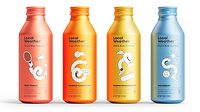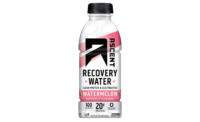2023 State of the Beverage Industry | Functional beverage demands lift sports, protein drink categories
Inflation impacts performance beverage market performance

Image courtesy of The Coca-Cola Co.
With function and sugar reduction driving much of consumers’ beverage choices today, the sports and protein drink markets are seeking an influx of innovation to meet the demands for healthy yet functional options.
Arielle Rose, senior industry research analyst at New York-based IBISWorld, explained in Beverage Industry’s May issue that sports and protein drinks have outperformed nonfunctional beverages in the past year.
That is exemplified by the category’s sales performance. According to data from Chicago-based Circana, the overall sports drinks category saw sales increase 12.4%, totaling $11.2 billion in total U.S. multi-outlets with convenience stores for the 52 weeks ending May 21. Although dollar sales were up, Circana data show that unit sales were down 5.5% during that same time period.
The majority of that performance was from the shelf-stable non-aseptic sports drink segment, which saw sales increase 10.7%, totaling $10.6 billion. The disparity between dollar sales and unit sales were exemplified with the segment down 6.2% in units.
Yet, experts highlight the popularity of functional beverages and the spot that sports drinks are fulfilling for consumers.
“The popularity of functional beverages has exploded in recent years, encouraged by the expansion of functional food and beverages and target marketing,” Rose noted. “Although many sports drinks had large amounts of calories and sugar, producers have introduced a plethora of new and healthier flavors over the year.”
For example, A-GAME Beverages Inc. released its same-named new, premium natural hydration sports drink. Formulated with the ideal ratio of sodium and potassium to create the ultimate hydration experience, A-GAME is designed to refuel, rehydrate and recover the body, the company says. It is made with natural ingredients free of artificial dyes, flavors, and sweeteners, eight essential vitamins, electrolytes, and minerals from unrefined sea salt, honey, and pure Icelandic glacier water.
Adriana Chychula, food, drink and nutrition analyst at Chicago-based Mintel, added that the sports and performance drink market had witnessed growth over the past year.

“Sports and performance drinks as a whole experienced an 18% increase compared to the year before,” she explained in Beverage Industry’s May issue. “Inflation is a part of that number, but it hasn’t deterred purchase as much as we’d expect. In fact, 32% of consumers said they bought more than the year before — more than decreased. This is true, even across the spectrum of financial comfort.”
Sally Lyons Wyatt, executive vice president and practice leader for Circana, Chicago, noted in Beverage Industry’s May issue that both segments “saw strong dollar growth” during the past 12 months. In Circana’s energy drink subcategory, which includes protein drinks, the market saw an increased unit growth of 5% in the last year. However, sports drinks declined 6%.
Wyatt noted that the sales performance indicates that price increase contributed to the dollar sales growth of sports drinks. This suggests that the costs, as well as the functional benefits, of these beverages is keeping consumers coming back for more, she said.
As consumers have placed more value on fitness and health lifestyles, expert noted that consumer demand has put more pressure on beverage companies to expand on product offerings.
“The elevation of fitness lifestyle trends has driven demand for sports and protein drinks higher, both of which are geared toward individuals looking to improve performance and recovery,” IBISWorld’s Rose said in Beverage Industry’s May issue. “For example, protein drinks are often consumed to improve muscle growth and recovery, while sports drinks help people replenish their electrolytes, which is especially helpful during strenuous routines.”
|
|
DOLLAR SALES | % CHANGE vs PRIOR YEAR | MARKET SHARE | % CHANGE vs PRIOR YEAR | |
| 1 | Gatorade | $7,055,229,962 | 12.7 | 66.3 | 1.2 |
| 2 | BODYARMOR | $1,492,083,994 | -9.2 | 14 | -3.1 |
| 3 | Powerade | $1,217,397,398 | -2.6 | 11.5 | -1.6 |
| 4 | Electrolit | $367,634,293 | 24.4 | 3.5 | 0.4 |
| 5 | Prime | $323,945,319 | 28.6 | 3.1 | 2.9 |
|
|
Category Total* | $10,635,348,527 | 10.7 | 100 | --- |
*Includes brands not listed
Source: Circana, Chicago. Total U.S. supermarkets, drug stores, gas and convenience stores, mass merchandisers, military commissaries, and select club and dollar retail chains for the 52 weeks ending May 21.
Adding to the options for protein drinks, Optimum Nutrition (ON), a brand of Glanbia Performance Nutrition, launched Gold Standard Protein Shake. The ready-to-drink option brings the whey protein powder brand ― Gold Standard ― into a grab-and-go format without compromising quality, the company says. The new drink option provides the ON standard in chocolate and vanilla flavors, and formulated with 24 grams of protein in each serving, it adds.
The shake is fortified with a blend of 24 essential vitamins and minerals including vitamins A, C, D, E and zinc to help support a healthy immune system; calcium to help support healthy teeth and bones; B vitamins to help convert food to cellular energy; and vitamins A, C and E for antioxidant support, the company notes.
Beverage-makers also are reformulating legacy brands to meet consumers’ demands for sports and protein drinks.
Powerade announced an all-new formula and new-look packaging at retail this year. Powerade’s new formula now comes with 50% more electrolytes compared with competitive sports drinks. The formula also includes vitamins C and B.
In a 2022 report from Beverage Marketing Corporation (BMC), New York, titled “The Evolving Drink Market in the U.S. Through 2026: Market Essentials,” the market research firm reports that sports drink wholesale dollars from 2016 to 2021 increased at a compound annual growth rate (CAGR) of 6.6% with sports drink volume experiencing a 2.6% CAGR during the same five-year timeframe.
The report also notes that the protein drink market accounts for slightly more than 10% of the sports drink market in terms of wholesale dollars. From 2016-2021, BMC reports that protein drink wholesale dollars had a CAGR of 10.3%.

Going forward, BMC projects that the sports drink market will grow even faster than it had during the 2016-2021 five-year period.
“The 2021–2026 compound annual growth rate (CAGR) for wholesale dollars is expected to be a solid 7.4%, versus a 3.2% volumetric CAGR,” the report states.
For the protein drink category, BMC prognosticates a 10.5% wholesale dollar CAGR for the 2021-2026 five-year period, which it attributes to the vanguard consumer trends, but cautions its long-term status.
“The popularity of keto/paleo diets is not likely to abate in the next several years, which should bode well for protein drinks,” the report states. “Another positive trend is the move towards plant-based foods, not least in the protein space. (What initially seemed a bit faddish could well prove to be a sustainable phenomenon.) On the negative side, although protein itself has been a hot macronutrient of late, there is no guarantee this will continue indefinitely.”
Looking for a reprint of this article?
From high-res PDFs to custom plaques, order your copy today!







